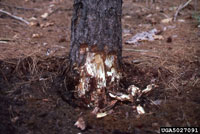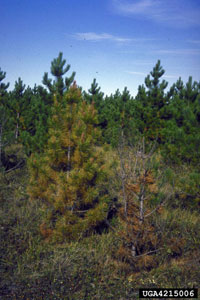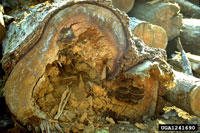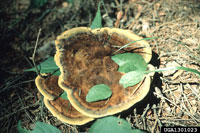Extension > Garden > Diagnose a problem > What's wrong with my plant? > Evergreen Trees and Shrubs > Fir > Tree breaks or falls over
Fir > Whole tree > Tree breaks or falls over
1 of 2
Armillaria root rot
Armillaria spp.
- Infected trees have reduced growth, dead branches in the upper canopy, browning needles, may produce an abundant crop of cones and eventually die
- Flat white sheets of fungal growth (mycelial fans) between the bark and sapwood at the base of infected trees
- Thick, black shoestring-like fungus can sometimes be seen under the bark at the root collar and in the soil near the base of the tree
- The base of the tree just below the soil surface may be encrusted in resin
- Wood is decayed, white, soft and spongy, beginning with the roots and may extend from the base of the tree well up into the trunk
- Trees frequently break or fall over in storms
- Clusters of honey-colored mushrooms may grow at the base of the tree in fall
- More information on Armillaria root rot
2 of 2
Brown Root and Butt Rot
Phaeolus schweinitzii
- Slow growth, thin canopy and discolored needles in severely infected trees
- Infection causes decay of heartwood in trunk and roots
- Decaying wood has brown, cubical rot
- Affected trees are often scattered, not adjacent
- Infected trees frequently break or lodge in storms
- 10"-12" fungal conks on trunk or several feet away from tree, velvety dark brown above and porous, light brown underneath
- Most pines and conifers are susceptible
- More information on Brown Root and Butt Rot









